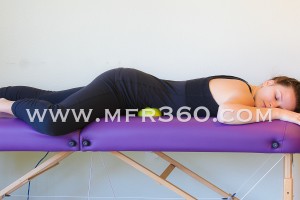Three of the most common muscles in the body where we hold tension are known as the Tension Triad: Pterygoid, Psoas, and Piriformis. In Tension Triad Part I: The Pterygoid we discussed the pterygoid muscle and its effects on the body and explained the reasons these areas get tight. The second member of the Triad is the Psoas (pronounced so-as) Muscle. It is one of the primary muscles for flexing the hip. It emerges from the transverse processes of all lumbar vertebrae and the side bodies of the last thoracic and all lumbar vertebrae in addition to the front surfaces of the lumbar discs. It courses down and in front of the pelvis and attaches to the lessor trochanter (high inside) of the femur (upper leg bone). This muscle is sometimes collectively called the Iliopsoas muscle because of its close proximity to the Iliacus muscle which is another primary hip flexor. The iliacus begins in the fossa(depression) of the top 2/3 of ilia (pelvic bone) on the front side up to the lip of the iliac crest (forms the waist line). The relative position of this muscle is through the body but just behind it, about the same level of the L3-L4 intervertebral disc, the L4 Vertebrae, and the L4-L5 disc. Fascial restrictions that produce pain patterns are often clinically reported in the low back to the side of the spine just over the waist line on either side.
A possible contributor to this type of low back pain is fascial restrictions anteriorly along the front aspect of the vertebral bodies pulling them into flexion closing the disc space in the front and creating a situation for discs to herniate in the back and laterally towards the spinal cord and nerve roots respectively where sensitive pain fibers reside. This myofascial (muscle and fascia) pulling also contributes to an anterior pelvic tilt or “sway back” condition, pelvic torsion, and upslips of the ilia on the sacrum. We spend a large percentage of our days sitting at desks, driving to and from work, watching tv, and engaging in various computer activities where our hips are flexed and our knees are pulled closer to our trunk. Prolonged sitting without stretching tends to tighten the iliacus and the psoas muscles, limit hip extension, and eventually pull the spine out of proper alignment. My patients often report “not doing anything” they can recall to precipitate the onset of back pain which usually lands them in Physical Therapy.
A list of commonly reported scenarios are:
-
“I woke up like this!”
-
“I bent over to brush my teeth.”
-
“I picked up my grandchild.”
-
“I was getting out of my car.”
-
“I only bent over to pick up a pencil.”
I’ve heard all kinds of reports in 23 years as a Physical Therapist. None of these explanations in and of themselves is enough to CAUSE a back injury. Lying deep within the body and under it all are dysfunctional movement patterns and static habitual postures that set up the scenario known as the “THE STRAW THAT BROKE THE CAMEL’S BACK”. My experience has taught me that repetitive stress on the body in sustained positions without consistent postural adaptations, corrections, or modifications are enough to cause insidious onset of non-specific low back pain.
Wellness Self Check: To locate your Psoas Muscle find your belly button with two fingers, then come to either side about an inch or 2 and down an inch or two. Gently push your fingers into your belly back towards your spine. If this is tender, hot, or hard, you likely have a tight psoas muscle that needs attention. Another way to perform the Wellness Check is to use a 4 inch vinyl ball, and place it as shown in the photo below.

Lie on your belly on a yoga mat, a carpeted floor, or firm bed. Roll to either side (you will check both sides). Re-locate your belly button go out and down an inch or two, place the ball on the spot you found above. Gently roll your body on to the ball. Start with your leg on the same side as the ball and draw it up and out. Be sure to keep your hip and knee safe and comfortable and avoid positions that cause pain. Next, pull your arm on the same side into the position as shown out with the elbow bent. Always be mindful to not put stress on the neck, shoulders or hips. If it feels hard, tender to touch, or is uncomfortable, you are in the right place and your check in with yourself has revealed that you have a Psoas that needs some wellness work. To continue into Wellness that Works, remain on the ball for 5 minutes or until you feel the area is no longer hard or uncomfortable. Allow your breathing to slow down and enjoy the softening of your body over the ball. Play a 5 minute song on your iPod, or set a timer and wait to ensure you are holding a full 5 minutes. Remember to do both sides. If you notice pain or tension come up anywhere else in the body, this is the fascial voice and this is likely another area in your body that needs your attention.
There is a progression for this Wellness Self Check which includes self treatment for maintaining a healthy Psoas. There are also JFB/MFR Techniques for the myofascial restrictions around the psoas muscle that when performed by a skilled MFR Therapist, can provide significant relief for low back pain. If you are located in the South Louisiana area and would like more information about our services or to schedule an appointment go to: www.mfr360.com/contact
***If you are uncomfortable stretching yourself, have significant pain, do not understand the instructions for the wellness self check, or have a case of Herniated Disc or other pathology in the Low Back that has been diagnosed by a Physician or Chiropractor, then an assessment or a screening by a Myofascial Release (MFR) Therapist in your area may be able to help. This information is provided for educational purposes only to increase body awareness and is not meant to diagnose or treat any condition.
Checking in with our bodies is part of maintaining our overall Wellness. It is how we become aware of what is happening inside before our bodies scream at us in pain or break down on us due to ignoring muscle tension, unexpressed emotion, or any other imbalance that is allowed to continue over time without release. Please take time to treat yourself well, stretch, go for a walk, meditate, dance, listen to music you enjoy, journal, paint, draw or create in a way that is unique to you. Wellness involves all aspects of our being: physical, emotional, mental and spiritual. To be continued…Tension Triad Part III: Piriformis

Leave a Reply